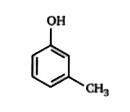Compound 'P', C7H8O is insoluble in water, dilute HCl and NaHCO3 . It dissolves in dilute NaOH . When P is treated with Br2−H2O , it converts rapidly into a compound of formula C7H5OBr3 . Identify structure of :




The correct Answer is:C
To identify the structure of compound 'P' with the formula C₇H₈O, we can follow these steps:
Step 1: Analyze the Solubility
- Compound 'P' is insoluble in water, dilute HCl, and NaHCO₃ but dissolves in dilute NaOH.
- This indicates that 'P' likely contains an acidic hydrogen, as it reacts with the base (NaOH).
Hint: Look for functional groups that can donate a proton (H⁺) to a base.
Step 2: Consider the Bromination Reaction
- When 'P' is treated with Br₂-H₂O, it converts to a compound with the formula C₇H₅OBr₃.
- The addition of three bromine atoms suggests that 'P' likely has a phenolic structure, which can undergo electrophilic aromatic substitution.
Hint: Think about how bromine reacts with aromatic compounds and the positions where it can add.
Step 3: Identify Possible Structures
- Given that 'P' has an acidic hydrogen and can react with bromine, it is likely a substituted phenol.
- The presence of a methyl group (CH₃) suggests that 'P' could be a methyl-substituted phenol.
Hint: Consider the positions of the methyl group relative to the hydroxyl group (–OH) on the benzene ring.
Step 4: Determine the Position of the Methyl Group
- The methyl group is an electron-donating group, which affects the reactivity of the aromatic ring.
- For bromination to occur at the ortho or para positions, the methyl group should be positioned in a way that does not hinder the electrophilic attack by bromine.
Hint: The meta position for the methyl group would allow bromination to occur at the ortho and para positions without interference.
Step 5: Conclude the Structure of Compound 'P'
- Based on the analysis, the structure of compound 'P' is likely 2-methylphenol (also known as ortho-cresol).
- The bromination of 2-methylphenol would lead to the formation of 2-bromo-4-methylphenol, which fits the formula C₇H₅OBr₃.
Hint: Verify the final structure by checking if it matches the molecular formula and the reactivity described.
Final Structure
The structure of compound 'P' is:
CH3∣C6H4−OH
(2-methylphenol or ortho-cresol)
- Compound 'P' is insoluble in water, dilute HCl, and NaHCO₃ but dissolves in dilute NaOH.
- This indicates that 'P' likely contains an acidic hydrogen, as it reacts with the base (NaOH).
- When 'P' is treated with Br₂-H₂O, it converts to a compound with the formula C₇H₅OBr₃.
- The addition of three bromine atoms suggests that 'P' likely has a phenolic structure, which can undergo electrophilic aromatic substitution.
- Given that 'P' has an acidic hydrogen and can react with bromine, it is likely a substituted phenol.
- The presence of a methyl group (CH₃) suggests that 'P' could be a methyl-substituted phenol.
- The methyl group is an electron-donating group, which affects the reactivity of the aromatic ring.
- For bromination to occur at the ortho or para positions, the methyl group should be positioned in a way that does not hinder the electrophilic attack by bromine.
- Based on the analysis, the structure of compound 'P' is likely 2-methylphenol (also known as ortho-cresol).
- The bromination of 2-methylphenol would lead to the formation of 2-bromo-4-methylphenol, which fits the formula C₇H₅OBr₃.
The structure of compound 'P' is:
(2-methylphenol or ortho-cresol)
Similar Questions
Compound A (C7H8O) is insoluble in water, dilute HCl & aqueous NaHCO3, but it dissolves in dilute NaOH. When A is treated with Br2 water it is converted into a compound C7H5Obr3 rapidly. The structure of A is:
View Solution
Find compound with formula C4H8Br2
How many structure of (X) are possible?
View Solution
Knowledge Check
A compound 'A' (C7H8O) is insoluble in water, dilute Hcland aqueous NaHCO3 but soluble in dilute NaOH. When Ais treated with Br2−H2O, it is converted into a compound of formula C7H5Obr3. Compound A is :
A B
B C
C D
D
A compound P (C7H8O) is insoluble in water, dilute HCl, NaHCO3 but dissolve in dilute NaOH. When P is treated with bromine-water, it is converted into a compound of formula C7H7OBr. Compound P is :
A B
B C
C D
D
Compound A (C7H8O) is insoluble in water, dilute HCI & aqueous NaHCO3 , but it dissolves in dilute NaOH. When A is treated with Br2 water it is converted into a compound C7H5OBr3 rapidly. The structure of A is :
A B
B C
C D
D
Compound (A)C7H8O is insoluble in aqueous NaHCO3 and dissolves in aqueous NaOH and gives a characteristic colour with neutral FeCl3 . When treated with Br2(A) forms compound (B)C7H5OBr3.
The most probable structure of compound A is :
View SolutionAn organic compound (A) (C8H8O3) was insoluble in water, dilute HCI, and NaHCO3. It was soluble in NaOH. A solution of (A) in dilute NaOH was boiled and steam distilled and distillate was reacted with NaOH to give a yellow precipitate. The alkaline residue is acidifield to give a solid (B) (C7H6O3). (B) dissolves in aqueous NaHCO3 with the evolution of gas. Identify (A) and (B).
View SolutionCompound (A) C7H8O is insoluble in aqueous NaHCO3 and dissolves in aqueous NaOH and gives a characteristic colour with neutral FeCl3 . When treated with Br2 (A) forms compound (B) C7H5OBr3 .
The structure of compound (B) would be :
View SolutionCompound (A) C7H8O is insoluble in aqueous NaHCO3 and dissolves in aqueous NaOH and gives a characteristic colour with neutral FeCl3 . When treated with Br2 (A) forms compound (B) C7H5OBr3 .
The most probable structure of compound A is :
View SolutionCompound (A) C7H8O is insoluble in aqueous NaHCO3 and dissolves in aqueous NaOH and gives a characteristic colour with neutral FeCl3 . When treated with Br2 (A) forms compound (B) C7H5OBr3 .
The most probable structure of compound A is :
View Solution
